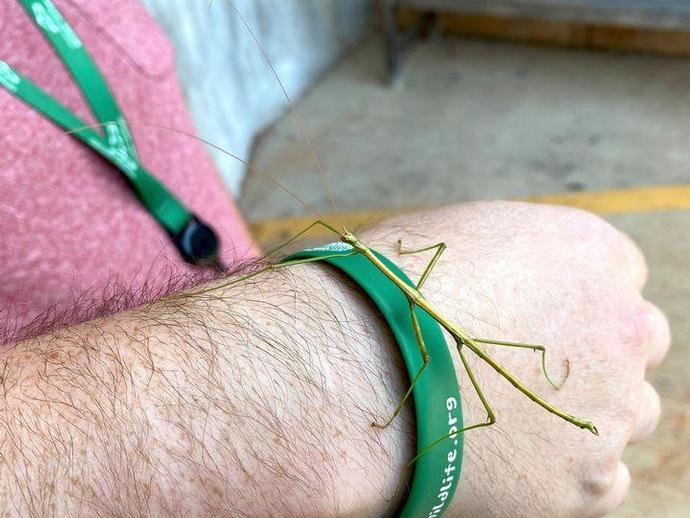August 3, 2021
It's time for today's edition of #BenInNature presented by our friends at Carter Bank & Trust!
This is the common walkingstick Diapheromera femorata (and the hand of VMNH Myriapodologist Dr. Jackson Means), and this species always reminds me of the terrible old joke:
Q: Why don't you see elephants hiding in trees?
A: Because they're good at it.
The common walkingstick is fairly abundant in the U.S., but I almost never spot them unless they're walking across asphalt or clinging to a building. These insects have evolved to camouflage themselves on trees, and they're very, very good at it!
Common walkingsticks are herbivores that skeletonize tree leaves by eating the soft tissue between the leaf veins. Although they're generalists, they still have a few tree species they prefer to feed on, such as oak and hazelnut. The adults like to feed high up in the canopy, which makes these insects even trickier to find.
During the day, the common walkingstick usually remains camouflaged. By folding their limbs along the length of their skinny bodies, these insects blend in almost perfectly, resembling nothing more than a twig. They will also sometimes rock their bodies back and forth in a rhythmic, repetitive motion that is believed to mimic a twig being buffeted by the wind. They generally do most of their feeding at night, between 9 p.m. and 3 a.m., when most of their predators are inactive.
If you'd like to see a stick insect yourself, they're definitely out there! We're currently in the middle of their breeding season and they should be active in Virginia until at least September.
ABOUT #BenInNature
Social distancing can be difficult, but it presents a great opportunity to become reacquainted with nature. In this series of posts, Administrator of Science Ben Williams ventures outdoors to record a snapshot of the unique sights that can be found in the natural world. New updates are posted Monday - Friday, with previous posts highlighted on the weekends. This series of posts is made possible thanks to the support of VMNH Corporate Partner Carter Bank & Trust (www.cbtcares.com).
NATURE PHOTO IDENTIFICATIONS
If you discover something in nature that you would like help identifying, be sure to message us right here on Facebook with a picture (please include location and date of picture) and we'll have our experts help you identify it!

 Hours & Admissions
Hours & Admissions Directions
Directions

